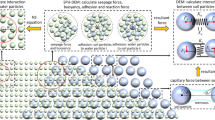Abstract
Reservoir sedimentation reduces the benefits from the storage of fresh water. The volume and distribution of sediment deposition must be predicted for a long term reservoir operation plan. Either or both experimental and numerical modeling can be applicable for an evaluation of reservoir sedimentation. Because sedimentation occurs along entire reservoirs and throughout the reservoir life span, a one-dimensional numerical sediment transport model, GSTARS, was considered in this study. Even though the model is not a truly two or three dimensional one, the model has capability of simulating channel geometric change in a semi-two dimensional manner using the stream tube concept. In this study, the effect of the number of stream tubes on the performance of the numerical simulation was analyzed using 14 years of real reservoir sedimentation data, and reasonable results were produced with three stream tubes. The densities of the deposited sediment depend on the reservoir operation scheme, especially for clay and silt. It was found that the predicted results vary with the density, and the prediction with various density with respect to location is required for a study reach where reservoir and river regions exit together.
Similar content being viewed by others
References
Ahn, J. (2011). Numerical modeling of reservoir sedimentation and flushing processes, PhD Dissertation, Colorado State University, USA.
Ahn, J., Yang, C. T., Boyd, P. M., Pridal, D. B., and Remus, J. I. (2013). “Numerical modeling of sediment flushing, from Lewis and Clark Lake.” International Journal of Sediment Research, Vol. 28, No. 2, pp 182–193, DOI: 10.1016/S1001-6279(13)60030-X.
Ahn, J. and Yang, C. T. (2014). “Simulation of lateral migration of All American Canal with semi-two dimensional sediment transport model.” KSCE Journal of Civil Engineering, Vol. 18, No. 6, pp. 1896–1903, DOI: 10.1007/s12205-014-0311-y.
Ahn, J. and Yen, H. (2015). “Semi-two dimensional numerical prediction of non-equilibrium sediment transport in reservoir using stream tubes and theory of minimum stream power.” KSCE Journal of Civil Engineering, Vol. 19, No. 6, pp. 1922–1929, DOI: 10.1007/s12205-014-0098-x.
Ahn, J. and Yang, C. T. (2015). “Determination of recovery factor for simulation of non-equilibrium sedimentation in reservoir.” International Journal of Sediment Research, Vol. 30, No. 1, pp 68–73, DOI: 10.1016/S1001-6279(15)60007-5.
Han, Q. (1980). “A study on the nonequilibrium transportation of suspended load.” Proceedings of the International Symposium on River Sedimentation, Beijing, China, pp. 793–802 (In Chinese).
Han, Q. (2003). Reservoir sedimentation, Science Publication, Beijing, China (in Chinese).
Han, Q. and He, M. (1990). “A mathematical model for reservoir sedimentation and fluvial processes.” International Journal of Sediment Research, Vol. 5, No. 2, pp 43–84.
Simões, F. J. M. and Yang, C. T. (2006). Sediment modeling for rivers and reservoirs, Chapter 5 erosion and sedimentation manual, U.S. Bureau of Reclamation, Technical Service Center, Denver Colorado.
Simões, F. J. M. and Yang, C. T. (2008). “GSTARS computer models and their applications, part II: Applications.” International Journal of Sediment Research, Vol. 23, No. 4, pp 299–315, DOI: 10.1016/S1001-6279(09)60002-0.
U.S. Bureau of Reclamation (1987). Design of small dams, 3rd edition, Denver, Colorado.
Yang, C. T. (1996). Sediment transport: Theory and practice, McGraw-Hill Companies, Inc., New York, (reprinted by Krieger Publishing Company, 2003).
Yang, C. T. and Simões, F. J. M. (2002). User’s manual for GSTARS3 (Generalized Sediment Transport model for Alluvial River Simulation version 3.0), Technical Service Center, U.S. Bureau of Reclamation, Denver, Colorado.
Yang, C. T. and Simões, F. J. M. (2008). “GSTARS computer models and their application, part I: Theoretical development.” International Journal of Sediment Research, Vol. 23, No. 3, pp 197–211, DOI: 10.1016/S1001-6279(08)60019-0.
Yang, C. T. and Marsooli, R. (2010). “Recovery factor for non-equilibrium sedimentation processes.” Journal of Hydraulic Research, Vol. 48, No. 3, pp 409–413, DOI:10.1080/00221686.2010.481842.
Yang, C. T. and Ahn, J. (2011). User’s manual for GSTARS4 (Generalized Sediment Transport model for Alluvial River Simulation version 4.0), Colorado State University, Fort Collins, Colorado, USA.
Author information
Authors and Affiliations
Corresponding author
Rights and permissions
About this article
Cite this article
Ahn, J., Song, C.G. Numerical modeling of long term reservoir sedimentation in semi-two dimensional manner. KSCE J Civ Eng 22, 135–140 (2018). https://doi.org/10.1007/s12205-017-1086-8
Received:
Revised:
Accepted:
Published:
Issue Date:
DOI: https://doi.org/10.1007/s12205-017-1086-8




